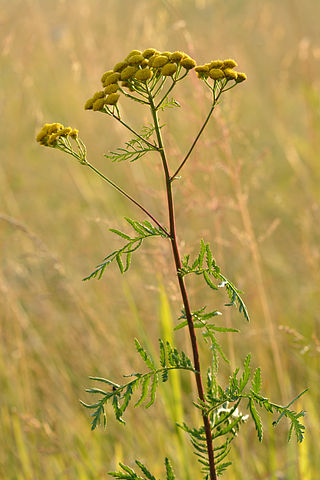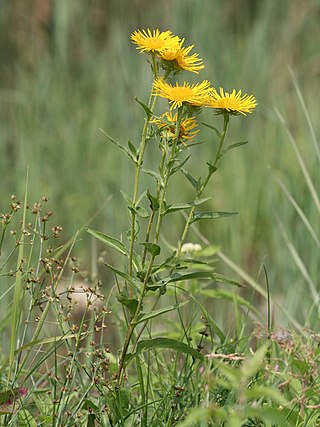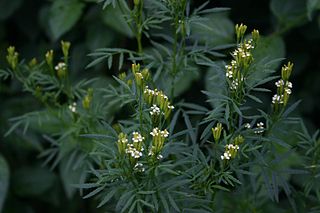
Tansy is a perennial, herbaceous flowering plant in the genus Tanacetum in the aster family, native to temperate Europe and Asia. It has been introduced to other parts of the world, including North America, and in some areas has become invasive. It is also known as common tansy, bitter buttons, cow bitter, or golden buttons. The Latin word vulgare means "common".

Quercetin is a plant flavonol from the flavonoid group of polyphenols. It is found in many fruits, vegetables, leaves, seeds, and grains; capers, red onions, and kale are common foods containing appreciable amounts of it. It has a bitter flavor and is used as an ingredient in dietary supplements, beverages, and foods.

Parthenolide is a sesquiterpene lactone of the germacranolide class which occurs naturally in the plant feverfew, after which it is named, and in the closely related tansy. It is found in highest concentration in the flowers and fruit. Parthenolide's molecular structure depiction is often incorrect regarding the stereochemistry of the epoxide, although X-ray single crystal structures are available.

The phenolic content in wine refers to the phenolic compounds—natural phenol and polyphenols—in wine, which include a large group of several hundred chemical compounds that affect the taste, color and mouthfeel of wine. These compounds include phenolic acids, stilbenoids, flavonols, dihydroflavonols, anthocyanins, flavanol monomers (catechins) and flavanol polymers (proanthocyanidins). This large group of natural phenols can be broadly separated into two categories, flavonoids and non-flavonoids. Flavonoids include the anthocyanins and tannins which contribute to the color and mouthfeel of the wine. The non-flavonoids include the stilbenoids such as resveratrol and phenolic acids such as benzoic, caffeic and cinnamic acids.

Oroxylin A is an O-methylated flavone, a chemical compound that can be found in the medicinal plants Scutellaria baicalensis and Scutellaria lateriflora, and the Oroxylum indicum tree. It has demonstrated activity as a dopamine reuptake inhibitor, and is also a negative allosteric modulator of the benzodiazepine site of the GABAA receptor. Oroxylin A has been found to improve memory consolidation in mice by elevating brain-derived neurotrophic factor (BDNF) levels in the hippocampus.

Kaempferide is an O-methylated flavonol, a type of chemical compound. It can be found in Kaempferia galanga. It has been noted to inhibit pancreatic cancer growth by blockading an EGFR-related pathway.

Isorhamnetin is an O-methylated flavon-ol from the class of flavonoids. A common food source of this 3'-methoxylated derivative of quercetin and its glucoside conjugates are pungent yellow or red onions, in which it is a minor pigment, quercetin-3,4'-diglucoside and quercetin-4'-glucoside and the aglycone quercetin being the major pigments. Pears, olive oil, wine and tomato sauce are rich in isorhamnetin. Others sources include the spice, herbal medicinal and psychoactive Mexican tarragon (Tagetes lucida), which is described as accumulating isorhamnetin and its 7-O-glucoside derivate. Nopal is also a good source of isorhamnetin, which can be extracted by supercritical fluid extraction assisted by enzymes.

Natsudaidain is an O-methylated flavonol, a type of chemical compound. It can be isolated from Citrus plants (Rutaceae). The name of the molecule comes from Citrus natsudaidai, a fruit of Japan developed in 1740 with a particularly tart/sour taste.

Trifolin is a chemical compound. It is the kaempferol 3-galactoside. It can be found in Camptotheca acuminata, in Euphorbia condylocarpa or in Consolida oliveriana.

Azaleatin is a chemical compound. It is an O-methylated flavonol, a type of flavonoid. It was first isolated from the flowers of Rhododendron mucronatum in 1956 and has since been recorded in forty-four other Rhododendron species, in Plumbago capensis, in Ceratostigma willmottiana and in Carya pecan. It has been also been found in the leaves of Eucryphia.

Syringetin is an O-methylated flavonol, a type of flavonoid. It is found in red grape, in Lysimachia congestiflora and in Vaccinium uliginosum. It is one of the phenolic compounds present in wine.

Laricitrin is an O-methylated flavonol, a type of flavonoid. It is found in red grape and in Vaccinium uliginosum. It is one of the phenolic compounds present in wine.

Centaureidin is an O-methylated flavonol. It can be isolated from Tanacetum microphyllum, Achillea millefolium, Brickellia veronicaefolia, Bidens pilosa and Polymnia fruticosa.

Ermanin is an O-methylated flavonol. It was isolated from Tanacetum microphyllum.

Patuletin is an O-methylated flavonol. It can be found in the genus Eriocaulon.

Jaceidin is an O-methylated flavonol. It can be found in Chamomilla recutita, in Centaurea jacea and can be synthesized. Jaceidin has many different characteristics, such as a molar mass of 360.31 g/mol. It also has a melting point of 130-135 °C.

Pentanema britannica, the British yellowhead or meadow fleabane, is a Eurasian species of plant in the daisy family. It is widespread across much of Europe and Asia, and sparingly naturalized in scattered locations in North America.

Mearnsetin is an O-methylated flavonol. It can be found in Eucalyptus globulus and in Elaeocarpus lanceofolius. The compound has antioxidative properties.

Catechin-7-O-glucoside is a flavan-3-ol glycoside formed from catechin.

Tagetes mendocina is a perennial herb commonly used as a medicinal plant and herb when cooking. It belongs to the family Asteraceae and is found in the Cuyo region in western Argentina.




















